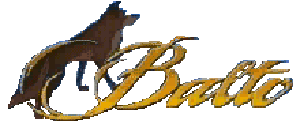

 Directed
by: Simon Wells
Directed
by: Simon Wells
Written by: David Cohen & Elana Lesser
Music by: James
Horner & Barry Mann
Released on: December 22, 1995
Running Time: 74 minutes
Budget: Less than $20 million
Box-Office: $11.3 million in the U.S.,
$ million worldwide
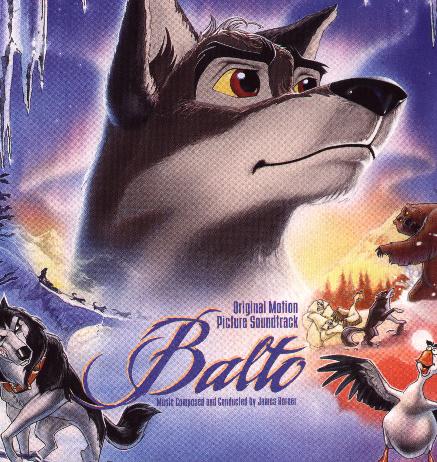 Balto...
Kevin
Bacon
Balto...
Kevin
Bacon
Jenna... Bridget Fonda
Boris... Bob Hoskins
Steele... Jim Cummings
Muk and Luk... Phil Collins
Nikki... Jack Angel
Kaltag... Danny Mann
Star... Robbie Rist
Ros... Juliette Brewer
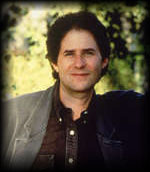 James
Horner was born on August 14, 1953. He began studying piano at the
age of five, and trained at the Royal College of Music in London, England,
before moving to California in the 1970s. After receiving a bachelor's
degree in music at USC, he would go on to earn his master's degree at UCLA
and teach music theory there. He later completed his Ph.D. in Music Composition
and Theory at UCLA. Horner began scoring student films for the American
Film Institute in the late 1970s, which paved the way for scoring assignments
on a number of small-scale films. His first large, high-profile project
was composing music for Star Trek: The Wrath of Khan (1982), which
would lead to numerous other film offers and opportunities to work with
world-class performers such as the London Symphony Orchestra. Currently,
with over 75 projects to his name, and work with people such as George
Lucas, Steven Spielberg, Oliver Stone, Ron Howard, and James Cameron (Aliens
and his most famous work, the Oscar-winner Titanic), James Horner
has firmly established himself as a strong voice in the world of film scoring.
In addition, he composed a classical concert piece in the 1980s, called
"Spectral Shimmers", which was world premiered by the Indianapolis Symphony
Orchestra. His contribution to the animated world is especially unvaluable,
with work on An American Tail,
The
Land Before Time as well as We're Back:
A Dinosaur's Story, and
Once Upon A Forest.
James
Horner was born on August 14, 1953. He began studying piano at the
age of five, and trained at the Royal College of Music in London, England,
before moving to California in the 1970s. After receiving a bachelor's
degree in music at USC, he would go on to earn his master's degree at UCLA
and teach music theory there. He later completed his Ph.D. in Music Composition
and Theory at UCLA. Horner began scoring student films for the American
Film Institute in the late 1970s, which paved the way for scoring assignments
on a number of small-scale films. His first large, high-profile project
was composing music for Star Trek: The Wrath of Khan (1982), which
would lead to numerous other film offers and opportunities to work with
world-class performers such as the London Symphony Orchestra. Currently,
with over 75 projects to his name, and work with people such as George
Lucas, Steven Spielberg, Oliver Stone, Ron Howard, and James Cameron (Aliens
and his most famous work, the Oscar-winner Titanic), James Horner
has firmly established himself as a strong voice in the world of film scoring.
In addition, he composed a classical concert piece in the 1980s, called
"Spectral Shimmers", which was world premiered by the Indianapolis Symphony
Orchestra. His contribution to the animated world is especially unvaluable,
with work on An American Tail,
The
Land Before Time as well as We're Back:
A Dinosaur's Story, and
Once Upon A Forest.
Thanks to the Official Balto Site
for some of the information below--check it out for more!
![]() Brendan Fraser
(1999's The Mummy) was originally hired to provide the voice of
Steele, the evil dog. He did record his part but his voiceover was subsequently
discarded and the role went to Jim Cummings.
Brendan Fraser
(1999's The Mummy) was originally hired to provide the voice of
Steele, the evil dog. He did record his part but his voiceover was subsequently
discarded and the role went to Jim Cummings.
![]() The nasty malamute,
"Steele", was rather ironically named after North-West Mounted Police Superintendent
Samuel B. Steele, one of the famous contingent of Mounted Police charged
with keeping order during the chaos of the 1896-1899 Klondike Gold Rush.
The nasty malamute,
"Steele", was rather ironically named after North-West Mounted Police Superintendent
Samuel B. Steele, one of the famous contingent of Mounted Police charged
with keeping order during the chaos of the 1896-1899 Klondike Gold Rush.
![]()
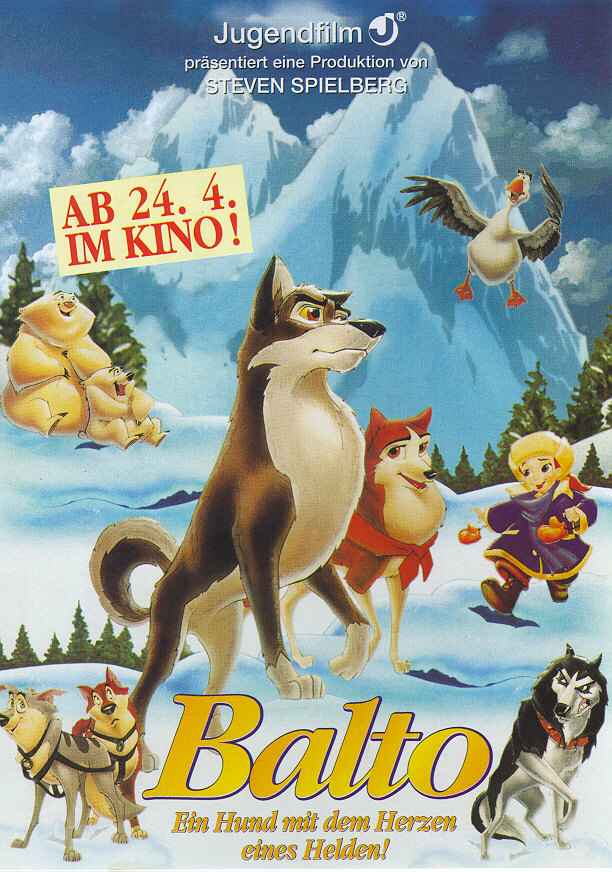 "Steele"'s
three-dog fan club, "Nikki", "Kaltag", and "Star", derive their names from
different sources. "Kaltag" is a town in Alaska that sits on the
route of the Iditarod Dog Sled Race. "Star" could be a generic reference
to the North Star, but could also be lifted from a tome on the Siberian
Husky, in which is stated, "one should avoid giving names to dogs that
are too phonetically similar to commands....(as)...the name 'Star' is too
similar to "Stay", etc.", in keeping with that particular Husky's personality
as depicted in the film.
"Steele"'s
three-dog fan club, "Nikki", "Kaltag", and "Star", derive their names from
different sources. "Kaltag" is a town in Alaska that sits on the
route of the Iditarod Dog Sled Race. "Star" could be a generic reference
to the North Star, but could also be lifted from a tome on the Siberian
Husky, in which is stated, "one should avoid giving names to dogs that
are too phonetically similar to commands....(as)...the name 'Star' is too
similar to "Stay", etc.", in keeping with that particular Husky's personality
as depicted in the film.
![]() "Nikki" is another
venture into irony. In 1960, a subsidiary of the Walt Disney Company
shot a film about sled-dogs on location in Banff, Alberta, entitled "Nikki,
Wild Dog of the North". After filming of the movie wound up, the
company found themselves with 200 or so sled dogs surplus to their requirements
and all in need of a good home. The various dogs that played the
title character "Nikki" (including "Nikki" himself), were given to the
Royal Canadian Mounted Police to form the foundation of their revitalized
breeding program for use in northern patrols.
"Nikki" is another
venture into irony. In 1960, a subsidiary of the Walt Disney Company
shot a film about sled-dogs on location in Banff, Alberta, entitled "Nikki,
Wild Dog of the North". After filming of the movie wound up, the
company found themselves with 200 or so sled dogs surplus to their requirements
and all in need of a good home. The various dogs that played the
title character "Nikki" (including "Nikki" himself), were given to the
Royal Canadian Mounted Police to form the foundation of their revitalized
breeding program for use in northern patrols.
![]() The animation
crew behind Balto was 98% European.
The animation
crew behind Balto was 98% European.
![]() A direct-to-video
sequel, Balto II: Wolf Quest, was released in 2001. This new adventure
picks up where Balto ended. After settling down with Jenna and having 6
pups, it soon becomes time for Balto to give his children up for adoption
to human families. However, no one wants Aleu, his daughter, because she
looks so much like a wolf. When Aleu figures this out, she runs away, forcing
Balto to go after her and sending her on a journey full of self discovery.
The voice cast includes Mark Hamill, Jody Benson (The
Little Mermaid, Thumbelina),
David Carradine and Lacey Chabert.
A direct-to-video
sequel, Balto II: Wolf Quest, was released in 2001. This new adventure
picks up where Balto ended. After settling down with Jenna and having 6
pups, it soon becomes time for Balto to give his children up for adoption
to human families. However, no one wants Aleu, his daughter, because she
looks so much like a wolf. When Aleu figures this out, she runs away, forcing
Balto to go after her and sending her on a journey full of self discovery.
The voice cast includes Mark Hamill, Jody Benson (The
Little Mermaid, Thumbelina),
David Carradine and Lacey Chabert.
Courtesy of DogSled.com
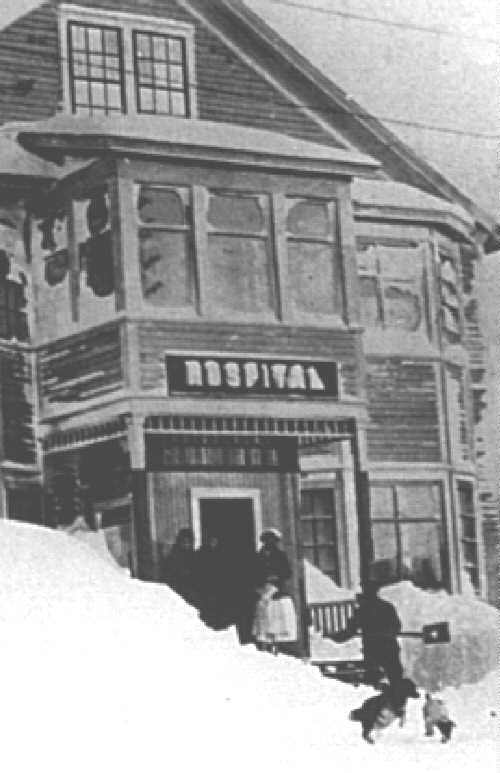 Nome,
Alaska appeared on the map during one of the world's great gold rushes
at the end of the century. Located on the Seward Peninsula, by 1900 the
town's population had swelled to 20, 000 after gold was discovered on beaches
along the Bearing Sea. By 1925, however, much of the gold was gone, and
scarcely 1, 400 people were left in the remote nothern outpost. Nome was
icebound seven months of the year and the nearest railroad was more than
650 miles away, in the town of Nenana.
Nome,
Alaska appeared on the map during one of the world's great gold rushes
at the end of the century. Located on the Seward Peninsula, by 1900 the
town's population had swelled to 20, 000 after gold was discovered on beaches
along the Bearing Sea. By 1925, however, much of the gold was gone, and
scarcely 1, 400 people were left in the remote nothern outpost. Nome was
icebound seven months of the year and the nearest railroad was more than
650 miles away, in the town of Nenana.
Nome was able to communicate with the rest of the world via the radio
telegraph, a relatively new invention in those days. And, although Alaska
was still a U.S. Territory until 1959, the government maintained a route
over
which relays of dog teams carried mail from Anchorage to Nome. A one-way
trip along this route, called the Iditarod Trail, took about a month and
the "mushers" that traversed the trail were the best in Alaska.
A CRY FOR HELP
On January 20, 1925, a radio signal went out, flashing for miles across
the frozen tundra:
Nome calling... Nome calling... We have an outbreak of diphtheria... No Serum... Urgently need help... Nome calling... Nome calling...
Nome's only doctor had diagnosed cases of diphtheria, an extremely
contageous disease affecting the throat and lungs, which can easily reach
epidemic proportions. The Inuit Indians were particularly vulnerable. Whole
villiages had been wiped out by earlier epidemics of measles and flu. The
frantic search for antitoxin began:
Seattle calling... Seattle calling... Fresh serum available here... Airplanes standing by to fly to Nome...
A RACE FOR LIFE
The long twilight of the arctic winter had settled over Nome. Heavy
snow had fallen and temperatures dropped far below zero. These weather
conditions were beyond the technical capabilities of early airplanes with
open cockpits.
Anchorage calling... Anchorage calling... 300, 000 units of serum located in railway hospital here... Package can be shipped by train to Nenana... Package weighs 20 pounds... Could serum be carried to Nome on Iditarod trail by mail drivers and dog teams?
Even though it was the 20th century, some problems could not be
solved with machines. For years the settlers of Alaska had trusted in courageous
men and strong dogs. They would trust in them again.
By the next day, three children in Nome had died of diphtheria and more
cases had been diagnosed. Time would be a matter of life and death. A relay
of dog teams along the Iditerod Trail was quickly organized.
JANUARY 27, 1925
The serum arrived in Nenana by train, and the relay to the stricken
city began. "Wild Bill" Shannon lashed the life-saving cargo to his sled
and set off westward. Except for the dogs' panting and the swooshing of
runners on the snow, there were no other sounds on the trail. The temperature
was dropping fast. It was 30 degrees below zero when Shannon started. Then
it fell to 35 degrees... 40 degrees... 45 degrees... and finally 50 degrees
below in the arctic darkness. Shannon rushed on, mindless of the cold,
until he handed the serum over to Edgar Kalland in Tolovana, 52 miles from
Nenana.
JANUARY 28, 1925
 Kalland,
in turn, passed the serum to Dan Green at Manley Hot Springs (31 miles).
Green took it to Fish Lake (28 miles), averaging an astonishing nine miles
an hour. From Green it passed to Johnny Folger (26 miles). He passed it
on to Sam Joseph (34 miles), then to Titus Nikolai (24 miles) and Dave
Corning (30 miles). New snow fell and the wind picked up, creating whiteouts,
but on and on the mushers went: Harry Pitka (30 miles), Bill McCarty (28
miles), and Edgar Nollner (24 miles). Eskimo, Indian, and white mushers
carried serum in the "Great Race of Mercy." The relay teams were challenging
the limits of endurance. From frozen hands to frozen hands the serum passed,
itself frozen until thawed out in one of the shelters, only to freeze solid
again on the trail.
Kalland,
in turn, passed the serum to Dan Green at Manley Hot Springs (31 miles).
Green took it to Fish Lake (28 miles), averaging an astonishing nine miles
an hour. From Green it passed to Johnny Folger (26 miles). He passed it
on to Sam Joseph (34 miles), then to Titus Nikolai (24 miles) and Dave
Corning (30 miles). New snow fell and the wind picked up, creating whiteouts,
but on and on the mushers went: Harry Pitka (30 miles), Bill McCarty (28
miles), and Edgar Nollner (24 miles). Eskimo, Indian, and white mushers
carried serum in the "Great Race of Mercy." The relay teams were challenging
the limits of endurance. From frozen hands to frozen hands the serum passed,
itself frozen until thawed out in one of the shelters, only to freeze solid
again on the trail.
JANUARY 30, 1925
At Galena, Edgar Nollner gave the serum to his newly married brother,
George. The young Indian chanted Athabascan love songs through the wilderness
to keep warm in the minus 50° weather. On his 30-mile stretch, Charlie
Evans harnessed himself to the sled when two dogs froze on their feet.
The serum passed on to Tommy Patsy (36 miles); Jackscrew, the Koyukuk Indian
(40 miles); Victor Anagick (34 miles); Myles Gonangnan (40 miles). Men
and dogs used their own bodies to break trail through four-foot snow drifts.
JANUARY 31, 1925
At Shaktolik, Henry Ivanoff had traveled a half-mile along the trail
when his team darted after a reindeer. While untangling the dogs, the Russian
Eskimo spotted Leonard Seppala, the greatest musher in the territory, and
Togo, one of the territory's greatest dogs, rushing down the trail. Due
to a breakdown in communications, Seppala and his famous Siberian huskies
had set out from Nome, 150 miles away, to meet the relay and return with
the serum. The serum was handed off to Seppala, who mushed 91 miles to
the next relay point. Each dog on a team has an important position, but
it is the leader that must guide them through safely. In addition to having
courage and endurance, a leader like Togo must be obediant and have an
uncanny instinct to find the trail and sense danger. As the storm grew
more vicious, Seppala was faced with the decision of whether to take a
shortcut across frozen, and yet dangerous, Norton Sound or to go around
it. Gale-force winds hurled seawater over the ice, which threatened to
break up at any moment. But Seppala was confidant of his team, and Togo
unearringly led them across the jagged, groaning ice floes to the safety
of land. Just three hours later, the ice broke in Norton Sound.
FEBRUARY 1, 1925
Through blinding snow and hurricane force winds, the desperately needed
serum was passed from Seppala to Charlie Olson (25 miles) and then to Gunnar
Kaasen. Had Kaasen an inkling of how wild the storm would rage, he would
not have chosen Balto to lead his team
out of Bluff. Although Balto was one of Seppala's dogs, he simply was not
thought of as a very good leader. But Balto proved his mettle when he plunged
into the roaring blizzard, at one point halting to save driver and team
from instant death in the Topkok River. No one believed Kaasen would make
it through the storm, so when he arrived at the Safety Shelter, 21 miles
from Nome, he found the next driver asleep. The team was running well and
so they forged ahead. Their endurance was tested even further when a sudden,
fierce blast of wind lifted both sled and dogs into the air. While fighting
to right the sled and untangle the team, Kaasen's heart sunk - the serum
was gone! Only after frantically searching the snow with his bare hands
did he miraculously find it.
FEBRUARY 2, 1925
Before daybreak on February 2, 1925, Balto led Gunnar Kaasen's team
into Nome. The town was saved! Exhausted and nearly frozen after the 53-mile
run, Kaasen, Balto and the rest of the mushing team became instant heroes
across the United States. The 674-mile trip was made in 1271/2 hours, considered
by mushers to be a world's record.
TIMELESS HEROES
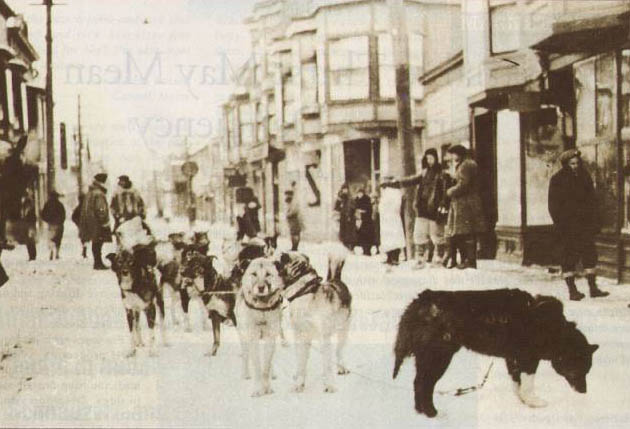 The
glory showered on the dogs was short-lived. Hollywood movie producer Sol
Lesser brought the dogs to Los Angeles and created a 30-minute film, Balto's
Race to Nome. His son later explained: "Ages ago, Balto, the sled dog
hero of Universal's animated feature, was as famous as reigning sports
champs Babe Ruth and Jack Dempsey. After the Alaskan dog made his
dangerous 1925 race with serum to beleaguered Nome, he appeared onstage
in first-run Los Angeles theatres, presented by my father, producer-exhibitor
Sol Lesser. Father also made a film of him, then trucked him to 3rd
Street grammar school so my sister Marjorie and I could show him to classmates.
By 1927, Balto had moved to an L.A. sideshow, exhibited for 10 cents admission.
An Ohio man bought him for a comfortable retirement in Cleveland's Brookside
Zoo, where Balto died in 1933. Balto was so popular that he was stuffed
and reverently placed in the Cleveland Museum of Natural History, where
he has inspired generations of visitors ever since."
The
glory showered on the dogs was short-lived. Hollywood movie producer Sol
Lesser brought the dogs to Los Angeles and created a 30-minute film, Balto's
Race to Nome. His son later explained: "Ages ago, Balto, the sled dog
hero of Universal's animated feature, was as famous as reigning sports
champs Babe Ruth and Jack Dempsey. After the Alaskan dog made his
dangerous 1925 race with serum to beleaguered Nome, he appeared onstage
in first-run Los Angeles theatres, presented by my father, producer-exhibitor
Sol Lesser. Father also made a film of him, then trucked him to 3rd
Street grammar school so my sister Marjorie and I could show him to classmates.
By 1927, Balto had moved to an L.A. sideshow, exhibited for 10 cents admission.
An Ohio man bought him for a comfortable retirement in Cleveland's Brookside
Zoo, where Balto died in 1933. Balto was so popular that he was stuffed
and reverently placed in the Cleveland Museum of Natural History, where
he has inspired generations of visitors ever since."
 Indeed,
Kaasen and his team then toured the U.S. during the summer and fall of
1925. In 1926, in honor of the epic trek, admirers erected a statue
of Balto in New York City's Central Park. But later Balto and
the rest of the dog team were sold to an unknown vaudeville promoter. Two
years later, Balto and his famous companions had become lost in the world
of sideshows and the whirl of the roaring twenties. It seemed the world
had forgotten the "Heroes of Alaska." Then, on a visit to Los Angeles,
Cleveland businessman George Kimble discovered the dogs displayed at a
"dime" museum and noticed that they were ill and mistreated. He knew the
famous story of Balto and was outraged at seeing this degradation. A deal
was struck to buy the dogs for $2, 000 and bring them to Cleveland - but
Kimble had only two weeks to raise the sum. The race to save Balto was
on!
Indeed,
Kaasen and his team then toured the U.S. during the summer and fall of
1925. In 1926, in honor of the epic trek, admirers erected a statue
of Balto in New York City's Central Park. But later Balto and
the rest of the dog team were sold to an unknown vaudeville promoter. Two
years later, Balto and his famous companions had become lost in the world
of sideshows and the whirl of the roaring twenties. It seemed the world
had forgotten the "Heroes of Alaska." Then, on a visit to Los Angeles,
Cleveland businessman George Kimble discovered the dogs displayed at a
"dime" museum and noticed that they were ill and mistreated. He knew the
famous story of Balto and was outraged at seeing this degradation. A deal
was struck to buy the dogs for $2, 000 and bring them to Cleveland - but
Kimble had only two weeks to raise the sum. The race to save Balto was
on!
 A
Balto fund was established. Across the nation, radio broadcasts appealed
for donations. Headlines in The Plain Dealer told of the push to rescue
the heroes. Cleveland's response was explosive. School children collected
coins in buckets; factory workers passed their hats; and hotels, stores,
and visitors donated what they could to the Balto fund. The Western Reserve
Kennel Club gave a needed finantial boost. The people had responded generously.
In just ten days the headlines read, "City Smashes Over Top With Balto
Fund! Huskies To Be Shipped From Coast at Once!"
A
Balto fund was established. Across the nation, radio broadcasts appealed
for donations. Headlines in The Plain Dealer told of the push to rescue
the heroes. Cleveland's response was explosive. School children collected
coins in buckets; factory workers passed their hats; and hotels, stores,
and visitors donated what they could to the Balto fund. The Western Reserve
Kennel Club gave a needed finantial boost. The people had responded generously.
In just ten days the headlines read, "City Smashes Over Top With Balto
Fund! Huskies To Be Shipped From Coast at Once!"
On March 19, 1927, Balto and six companions were brought to Cleveland and given a heroes' welcome in a triumphant parade through the Public Square. The dogs were then taken to the Cleveland Zoo to live out their lives in dignity. It was said that 15, 000 people visited them on their first day there.
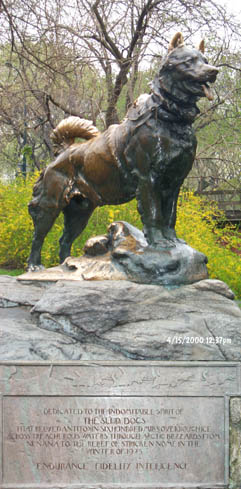 Balto
died on March 14, 1933, at the age of 11. The husky's body was mounted
at The Cleveland Museum of Natural History, where it has been kept as a
reminder of the gallant race against death. Today, some Alaskan schoolchildren
are campaigning to bring Balto back to his home state. The students want
his body moved to the Iditarod Trail Sled Dog Race museum in Wasilla. But
Cleveland officials aren't ready to give Balto back, noting he spent more
than half his life in their city. Balto did return to Alaska though in
1999 as part of a temporary exhibit at the Anchorage Museum of History
and Art -a testament to the strength of Balto's memory and a fitting memorial
to his indomitable spirit. Balto was suddenly a world-famous celebrity;
for two years after the serum run, the dog and some of his teammates traversed
the continental United States as part of a traveling show. After Balto
died in 1933, his body was preserved and displayed at Cleveland's Natural
History Museum.
Balto
died on March 14, 1933, at the age of 11. The husky's body was mounted
at The Cleveland Museum of Natural History, where it has been kept as a
reminder of the gallant race against death. Today, some Alaskan schoolchildren
are campaigning to bring Balto back to his home state. The students want
his body moved to the Iditarod Trail Sled Dog Race museum in Wasilla. But
Cleveland officials aren't ready to give Balto back, noting he spent more
than half his life in their city. Balto did return to Alaska though in
1999 as part of a temporary exhibit at the Anchorage Museum of History
and Art -a testament to the strength of Balto's memory and a fitting memorial
to his indomitable spirit. Balto was suddenly a world-famous celebrity;
for two years after the serum run, the dog and some of his teammates traversed
the continental United States as part of a traveling show. After Balto
died in 1933, his body was preserved and displayed at Cleveland's Natural
History Museum.
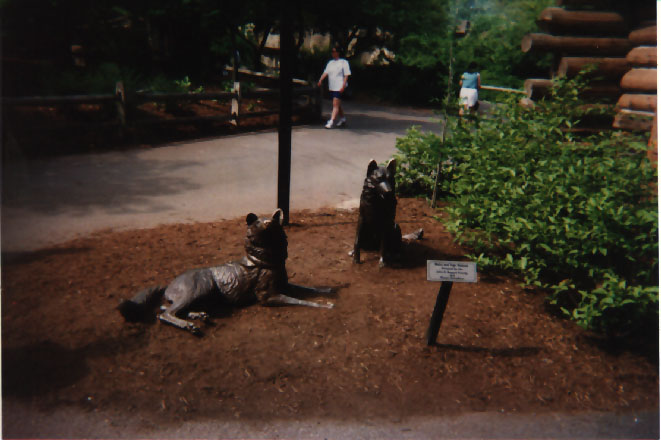 Long
after his death, Balto's popularity lives on. Today, some Alaskan schoolchildren
are campaigning to bring Balto back to his home state. The students want
his body moved to the Iditarod Trail Sled Dog Race museum in Wasilla. But
Cleveland officials aren't ready to give Balto back, noting he spent more
than half his life in their city. Balto returned to Alaska in 1999 as part
of a temporary exhibit at the Anchorage Museum of History and Art -a testament
to the strength of Balto's memory and a fitting memorial to his indomitable
spirit.
Long
after his death, Balto's popularity lives on. Today, some Alaskan schoolchildren
are campaigning to bring Balto back to his home state. The students want
his body moved to the Iditarod Trail Sled Dog Race museum in Wasilla. But
Cleveland officials aren't ready to give Balto back, noting he spent more
than half his life in their city. Balto returned to Alaska in 1999 as part
of a temporary exhibit at the Anchorage Museum of History and Art -a testament
to the strength of Balto's memory and a fitting memorial to his indomitable
spirit.
|
||||||||||||